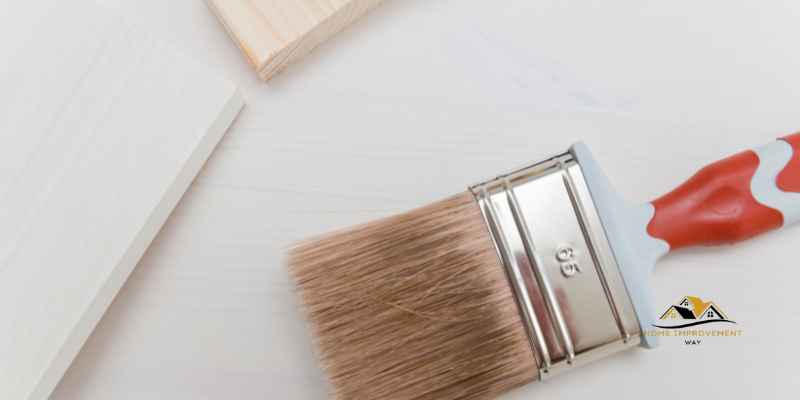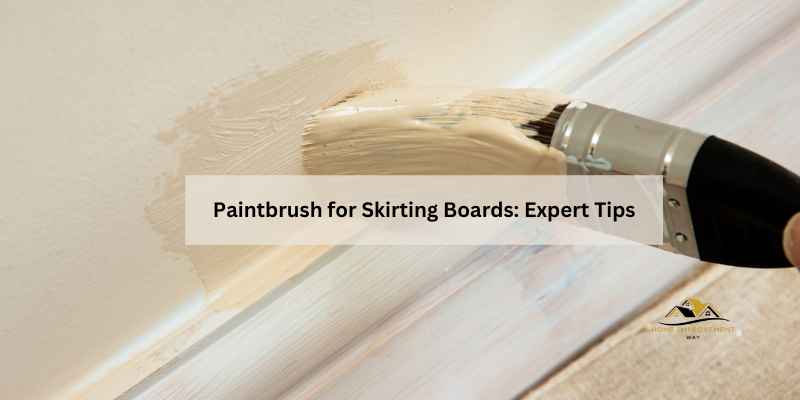The best paintbrush for skirting boards depends on the type of paint being used and the surface texture. For gloss paint, use a brush with synthetic bristles, and for emulsion paint, use a brush with natural bristles.
When painting skirting boards, it is important to choose the right type of brush to ensure a smooth and even finish. In addition to the type of brush, it is also important to properly prepare the surface by cleaning and sanding, and to use the appropriate paint for the job.
This guide will provide tips and tricks for painting skirting boards like a pro, including the best brushes to use and how to avoid brush marks.
Choosing The Right Paintbrush
When it comes to painting skirting boards, it’s important to choose the right paintbrush. Look for a brush with angled bristles that can reach tight corners and edges. A stubby paintbrush with a short handle can also be useful for maneuvering around the baseboard.
Types Of Paintbrushes
When it comes to painting skirting boards, selecting the appropriate paintbrush is crucial. Various types of paintbrushes are available to suit different painting needs:
- Natural Bristle Brushes
- Synthetic Bristle Brushes
- Angled Brushes
- Trim Brushes
- Short Handle Brushes
Best Paintbrush For Skirting Boards
For achieving a flawless finish on skirting boards, it’s essential to choose the right paintbrush. The best paintbrush for skirting boards is the one that matches your painting technique and the type of paint you are using. Consider the following factors when selecting a paintbrush:
- Brush Material – Natural or Synthetic
- Brush Size – Choose a size that fits the width of your skirting board
- Brush Shape – Angled brushes are ideal for precise edges
- Handle Length – Short handle brushes offer better control
Remember, the quality of your paintbrush can significantly impact the final look of your painted skirting boards. Invest in a high-quality brush that suits your painting style and the type of paint you are using.
Preparation And Cleaning

When it comes to painting skirting boards, proper preparation and cleaning are essential to achieving a smooth and professional finish. Before you begin painting, it’s crucial to ensure that the surface is clean and free of any dust, dirt, or imperfections. In this section, we’ll discuss the importance of cleaning and sanding, as well as how to avoid brush marks, to help you achieve a flawless result for your skirting boards.
Importance Of Cleaning And Sanding
Cleaning and sanding are the foundational steps in preparing skirting boards for painting. Thoroughly cleaning the surface removes any dirt, grease, or previous paint residue, ensuring better adhesion of the new paint. Sanding helps to smooth out any imperfections, creating a uniform surface for the paint to adhere to.
Avoiding Brush Marks
To achieve a smooth and professional finish, it’s important to use high-quality brushes and apply the paint carefully. Avoiding brush marks can be achieved by using the right technique, such as long, smooth strokes and proper brush selection. Additionally, ensuring the paint is of the right consistency and not overworking the paint can help prevent brush marks.
Techniques For Painting Skirting Boards
When it comes to painting skirting boards, using the right techniques can make a significant difference in the outcome. From applying primer and paint to eliminating brush marks, each step plays a crucial role in achieving a professional finish.
Applying Primer And Paint
Before diving into the painting process, it’s essential to prepare the skirting boards properly. Start by cleaning the surface to remove any dust or debris. Then, apply a primer specifically designed for wooden surfaces. This will help the paint adhere better and provide a more uniform finish.
Once the primer has dried, choose a high-quality paintbrush suitable for the task. A brush with angled bristles can help reach tight corners and edges with ease. Apply the paint in smooth, even strokes, working from the top to the bottom. Allow the first coat to dry thoroughly before applying a second coat for a flawless result.
Eliminating Brush Marks
To achieve a smooth and professional look, it’s important to eliminate any brush marks left behind during the painting process. One effective method is to lightly sand the skirting boards between coats using fine-grit sandpaper. This helps smooth out any imperfections and creates a seamless finish.
Additionally, using a high-quality paintbrush and mastering the technique of laying off can significantly reduce the appearance of brush marks. After applying the paint, lightly run the brush over the surface in long, smooth strokes to level out any brush marks and achieve a flawless finish.
Expert Tips For A Professional Finish
When painting skirting boards, achieving a professional finish is essential for enhancing the overall look of your space. With the right techniques and tools, you can transform your skirting boards into a seamless and polished feature of your room.
Using The Correct Brush Size
Choosing the right brush size is crucial for precision and efficiency when painting skirting boards. Opt for a brush with a small to medium size, such as a stubby or angled sash brush, to easily navigate corners and edges.
Choosing The Right Paint Type
Selecting the appropriate paint type is key to achieving a flawless finish on your skirting boards. Consider using a high-quality gloss or eggshell paint that is durable and easy to clean for long-lasting results.
When it comes to painting skirting boards, opt for a quick-drying one-coat paint like Dulux Once for a fast and efficient application. However, for a more durable finish, take the time to apply a primer and at least two coats of paint.
Remember to invest in quality brushes like Wooster Brush Shortcut Angle Sash Paintbrush or Benjamin Moore Soft Tynex Angle Sash Brush for smooth and even coverage on your skirting boards.
Common Mistakes To Avoid
When it comes to painting skirting boards, it’s essential to be mindful of common mistakes that can compromise the quality of the final finish. By avoiding these errors, you can achieve a professional-looking result that enhances the overall aesthetic of your space. Here are some crucial missteps to steer clear of when painting skirting boards.
Roping Brush Marks
One common mistake to avoid when painting skirting boards is the occurrence of roping brush marks. These are unsightly ridges that form when the paint is applied unevenly or with the incorrect technique. To prevent roping brush marks, ensure that the paintbrush strokes are smooth and consistent, moving in the direction of the skirting board’s grain. Additionally, using a high-quality paintbrush with fine bristles can help achieve a more seamless finish.
Choosing Incorrect Paintbrush
Selecting the wrong paintbrush for skirting boards can lead to subpar results. Opt for a brush that is specifically designed for trim work, such as an angled sash brush or a stubby paintbrush. These brushes are tailored to navigate the intricate edges and corners of skirting boards, allowing for precise application and a professional finish. Furthermore, consider the size of the brush in relation to the width of the skirting board for optimal coverage.
Video Tutorials And Demonstrations
Learn the essential steps to perfectly paint your skirting boards.
- Prepare the skirting boards by cleaning and sanding them.
- Use painter’s tape to protect the walls and floor.
- Apply an undercoat or primer for better adhesion.
- Paint the skirting boards with a brush or roller, following the wood grain.
- Allow the paint to dry completely before applying a second coat if needed.
Enhance your painting skills with these expert tips.
- Choose the right paint brush size and type for skirting boards.
- Work in small sections to ensure even coverage.
- Use long, smooth strokes for a professional finish.
- Clean your brushes thoroughly after each use to prolong their lifespan.
Recommended Paintbrushes For Skirting Boards
When it comes to painting skirting boards, using the right paintbrush can make all the difference. The right brush can help you achieve a smooth finish, save time, and ensure efficient paint application. Here are some recommended paintbrushes for skirting boards that you should consider for your next painting project.
Top Paintbrush Brands
If you are looking for top-quality paintbrushes that deliver exceptional results, consider these renowned brands:
- Harris Brushes: Known for their high-quality bristles and ergonomic design, Harris brushes are a popular choice among professional painters.
- Wooster Brush: The Wooster Shortcut Angle Sash Paintbrush is a favorite among DIY enthusiasts for its precision and ease of use.
- Benjamin Moore: The Benjamin Moore Soft Tynex Angle Sash Brush is lauded for its durability and ability to deliver a smooth finish.
Budget-friendly Options
If you are on a budget but still want reliable paintbrushes for your skirting boards, consider these cost-effective options:
- Magimate Stubby Paintbrush: This trim angled sash brush offers a wooden short handle and is available at an affordable price, making it a great choice for budget-conscious individuals.
- Emery Edger: While not a traditional paintbrush, the Emery Edger Two Edging Tool is a budget-friendly option for achieving clean and precise edges on skirting boards without breaking the bank.
Faqs And Expert Advice

Looking for expert advice on what paintbrush to use for skirting boards? Consider the Wooster Brush Shortcut Angle Sash Paintbrush or the Magimate Stubby Paintbrush for a precise and easy-to-use option. Be sure to clean and sand your skirting boards before painting to avoid brush marks and achieve a polished finish.
Best Practices For Skirting Board Painting
1. Clean skirting boards thoroughly before painting.
2. Use painter’s tape to protect walls and floors.
3. Apply primer for better adhesion and finish.
Choosing The Right Finish For Skirting Boards
1. Consider a gloss finish for a shiny and durable look.
2. Opt for an eggshell finish for a subtle sheen.
Frequently Asked Questions
What Paint Brush To Use For Skirting Boards?
Use a 2-inch angled brush for skirting boards. Opt for synthetic bristles for smooth application.
What Is The Best Way To Paint Skirting Boards?
The best way to paint skirting boards is to use a quick-drying, one-coat paint like Dulux Once for a speedy finish. For a more durable outcome, apply a primer and at least two coats of paint. It’s essential to clean and sand the surface beforehand.
How To Avoid Brush Marks When Painting Skirting Boards?
To avoid brush marks when painting skirting boards, use a high-quality brush, apply thin coats, and paint in long, smooth strokes. Sand between coats for a smooth finish.
Why Do People Paint Skirting Boards White?
People paint skirting boards white to match walls, create a clean look, and brighten the room.
Conclusion
To achieve flawless skirting boards, choose the right paintbrush and follow expert techniques. Ensure cleanliness and sanding for a professional finish. Opt for quality paint for durability. Say goodbye to brush marks by using the correct brush and methods. Elevate your painting game with these tips!


